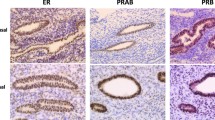Abstract
Approximately, one fourth of women have leiomyomas. Leiomyomas are benign tumors that originated from smooth muscle cells. Estrogen is claimed to relate as a cause but exact mechanism has not fully understood. In this study, 95 leiomyoma cases that have been diagnosed by our department in years between 2010 and 2012 were examined. Age ranges of patients, sizes, locations, and numbers of leiomyomas were identified. Immunohistochemically ER (estrogen), PR (progesterone), and Gross cystic disease fluid protein-15 stains were performed to the paraffin blocks and their percentages of staining were noted. Statistically, submucosal and intramural locations were significantly related to ER and PR (p < 0,001). There were significant relationship between ER and PR in 30–50 years age group (p < 0,001). There were significant relationship between ER, PR and locations (p < 0,001), numbers (p < 0,001), sizes of leiomyomas (below 5 cm; p < 0,001), (between 5 and 10 cm; p = 0,037), larger than 10 cm; p = 0,002). Consequently, relationship between leiomyoma and ER, PR were revealed in this study. Also, relationship between leiomyoma locations and patient ages were identified statistically. There was no immunoreactivity with GCDFP-15 in leiomyomas.



Similar content being viewed by others
References
Baird DD, Dunson DB, Hill MC, et al. High cumulative incidence of uterine leiomyoma in black and white women: ultrasound evidence. Am J Obstet Gynecol. 2003;188(1):100–7.
Zheng LH, Cai FF, Ge I, et al. Stromal fibroblast activation and their potential association with uterine fibroids (Review). Oncol Lett. 2014;8(2):479–86.
Serden SP, Brooks PG. Treatment of abnormal uterine bleeding with the gynecologic resectoscope. J Reprod Med. 1991;36(10):697–9.
Khan AT, Shehmar M, Gupta JK. Uterine fibroids: current perspectives. Int J Womens Health. 2014;29(6):95–114.
Marshall LM, Spiegelman D, Barbieri RL, et al. Variation in the incidence of uterine leiomyoma among premenopausal women by age and race. Obstet Gynecol. 1997;90(6):967–73.
Kaban I, Cengiz H, Ekin M, et al. Uterin leiomyom ön tanısı ile opere edilen olgularda preoperatif tanının postoperatif histopatolojiyi kestirmedeki değeri. Göztepe Tıp Derg. 2013;28(1):19–24.
Ibrar F, Riaz S, Dawood NS, et al. Frequency of fibroid uterus in multipara women in a tertiary care centre in Rawalpindi. J Ayub Med Coll Abbottabad. 2010;22(3):155–7.
Tavassoli FA, Purcell CA, Bratthauer GL, et al. Androgen receptor expression along with loss of bcl-2, ER, and PR expression in benign and malignant apocrine lesions of the breast: implications for therapy. Breast J. 1996;2:261–9.
Leal C, Henrique R, Monteiro P, et al. Page DL Apocrine ductal carcinoma in situ of the breast: histologic classification and expression of biologic markers. Hum Pathol. 2001;32(5):487–93.
Maruo T, Ohara N, Wang J, et al. Sex steroidal regulation of uterine leiomyoma growth and apoptosis. Hum Reprod Update. 2004;10(3):207–20.
Lefebure G, Vilos G, Allaire C, et al. The management of uterine leiomyoma. Clinical practice gynaecological committee. Obstet Gynecol Can. 2003;25:396–418.
Ashraf T. Management of uterine leiomyomas. J Coll Physicians Surg Pak. 1997;7:160–2.
Flake GP, Andersen J, Dixon D. Etiology and pathogenesis of uterine leiomyomas: a review. Environ Health Perspect. 2003;111(8):1037–54.
Palomba S, Sammartino A, Di Carlo C, et al. Effects of raloxifene treatment on uterine leiomyomas in postmenopausal women. Fertil Steril. 2001;76(1):38–43.
Polatti F, Viazzo F, Colleoni R, et al. Uterine myoma in postmenopause: a comparison between two therapeutic schedules of HRT. Maturitas. 2000;37(1):27–32.
Bharambe BM, Deshpande KA, Surase SG, et al. Malignant transformation of leiomyoma of uterus to leiomyosarcoma with metastasis to ovary. J Obstet Gynaecol India. 2014;64(1):68–9.
Bukulmez O, Doody KJ. Clinical features of myomas. Obstet Gynecol Clin North Am. 2006;33(1):69–84.
Compliance with ethical requirements and Conflict of interest
All procedures followed were in accordance with the ethical standards of the responsible committee. An ethical clearance has also been taken from the ethical committee (düzce university school of medicine, ethics committee of noninvasive clinical researchers approval for application (decision number:2013/381)).
The authors of the article Havva Erdem, Feyza Baþar, Nilüfer Kadýoðlu, Murat Oktay, Handan Ankaralý, Ali Yavuzcan, Anzel Bahadýr, Serdar Dilbaz declare that they have no conflict of interest.
Author information
Authors and Affiliations
Corresponding author
Rights and permissions
About this article
Cite this article
Erdem, H., Başar, F., Kadıoğlu, N. et al. Evaluation of Estrogen, Progesterone, and GCDFP-15 Expression in Uterine Leiomyomas. J Obstet Gynecol India 65, 335–338 (2015). https://doi.org/10.1007/s13224-014-0617-1
Received:
Accepted:
Published:
Issue Date:
DOI: https://doi.org/10.1007/s13224-014-0617-1




